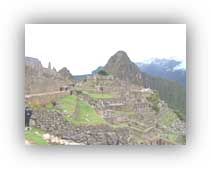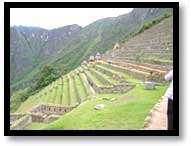MACHU PICCHU
People usually make the trip to Machu Picchu by way of a 4 hour train ride, then a final half hour switch-back bus trip from the train stop in the valley up to Machu Picchu. Our Expedition team varied this by doing the first part of the trip in a sightseeing bus and the final part by train. The bus traveled through the mountains and valleys of Peru outside Cusco: green, lush, peppered with small, quaint farm towns with dramatic mountain backdrops. With all the driving and being driven we have done, this trip stands out. The train ride follows the Urubamba River through the Sacred Valley. The river is now swollen with the summer rains and flows from swift to turbulent. The mountains are strewn with lush vegetation - the final portion of the train trip took us through tropical vegetation that included orchids, fuchsias, and begonias. An existential experience. The Machu Picchu site is huge. The Spanish never found it and so it was not destroyed. The City is therefore largely as it was 400 years ago. It is hard to fully describe why this site is so popular (today being New Year's Eve, there were record crowds). Many consider it to have powerful meridians (like Sedona). It is located in such an unlikely place, straddling a peak with extraordinary mountains all around it and the Urubamba River far below in the valley. Most cities AROUND THE WORLD are located in valley floors (and on the train trip we saw some Incan ruins closer to the valley) where the fertile One explanation for the choice of this unlikely site was that it is a Versailles-like location for a powerful ruler who, like the pharaohs, could command its construction. A further impetus for this herculean labor was that construction on this site had religious significance, making the project a spiritual exercise. Finally, the location of Machu Picchu is breathtaking. No matter where you stand the view is spectacular. Even though there are always many people there, Machu Picchu almost compels everyone to speak quietly because the grandeur is so overwhelming. |
 The trip from Cusco to Machu Picchu was one of those occasions where the journey was as memorable as the destination. The countryside going to the Sacred Site is magnificent.
The trip from Cusco to Machu Picchu was one of those occasions where the journey was as memorable as the destination. The countryside going to the Sacred Site is magnificent.
 soils are and where the rivers have the chance to fertilize the land with runoff and periodic flooding. In building Machu Picchu where they did, the Incas had to bring fertile soil up to terraces that they constructed to grow their crops. The terraces and the structures all had to be built with strong retaining walls (with stone foundations three to four feet below the surface) and the walls of the structures themselves had to be sturdy. The Inca's chose stone as their building material for all of the above and, as noted earlier, they were superb stone masons.
soils are and where the rivers have the chance to fertilize the land with runoff and periodic flooding. In building Machu Picchu where they did, the Incas had to bring fertile soil up to terraces that they constructed to grow their crops. The terraces and the structures all had to be built with strong retaining walls (with stone foundations three to four feet below the surface) and the walls of the structures themselves had to be sturdy. The Inca's chose stone as their building material for all of the above and, as noted earlier, they were superb stone masons.